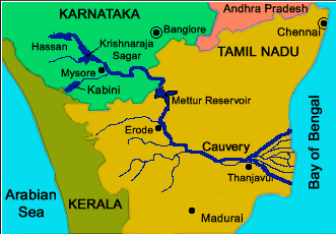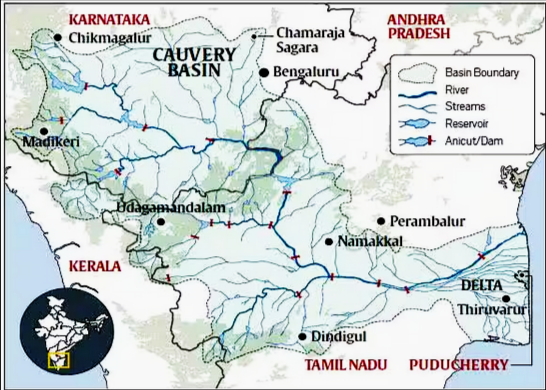GS1-Geography
The Cauvery Water Dispute is a protracted conflict between the Indian states of Tamil Nadu and Karnataka over the allocation of water from the Cauvery River. This dispute, rooted in historical agreements, has been a source of tension for over a century.
Root Cause of the Cauvery Water Dispute
- The core issue in the Cauvery River dispute, which involves four states—Karnataka, Tamil Nadu, Kerala, and the Union Territory of Puducherry—revolves around the equitable distribution of the river's total water volume of 740 TMC (thousand million cubic feet).
- The pivotal moment in this protracted conflict came with the 2007 tribunal award, directing Karnataka to allocate an additional 192 TMC of river water to support irrigation in Tamil Nadu. This allocation, intended to benefit Tamil Nadu farmers, has been a persistent source of irritation for the Karnataka Government, particularly in years marked by weak monsoons.
- Karnataka, cognizant of potential flooding risks, typically releases more than the mandated 192 TMC during normal monsoons to prevent adverse local conditions. However, the crux of the problem emerges during years of weakened monsoons, a phenomenon attributed to climate change affecting both the Southwest and Northeast monsoons that contribute to the Cauvery's rainfall. In such instances, the intricacies of the tribunal's monthly release directive become more pronounced, leading to tensions between the states.
- The historical backdrop is marred by protests, with 2016 witnessing an escalation into violent confrontations. The clashes resulted in widespread vandalism, causing significant damage to property and, tragically, loss of human lives. The paradox of such conflict unfolding in a nation considered water-rich underscores the pressing need for improved water management and distribution practices in India.
|
Cauvery (Kaveri) River
Tributaries
Distributaries Distributaries include Kollidam (Coleroon river), Vennar, and Arasalar, each playing a role in shaping the river's journey towards the Bay of Bengal. Origin: The source, Talakaveri, sits proudly at an elevation of 1,341 meters above sea level. Length: The river spans an impressive length of 800 kilometers. Geographical Coverage Surrounded by the Western Ghats to the west, guarded by the Eastern Ghats in the east and south, and separated from the Krishna and Pennar basin in the north by ridges. Hydroelectric Power and Irrigation Beyond its spiritual significance, the river serves practical purposes, generating hydroelectric power and aiding in irrigation. The fertile delta formed before merging into the Bay of Bengal is rightly hailed as the 'garden of southern India.' Soils and River Basin The most fertile area lies in the delta, with a rich mix of black, red, alluvial, laterites, forest, and mixed soils. The river basin is a triad of the Western Ghats, the Plateau of Mysore, and the Delta. Mettur Dam
Mekedatu project
|
Historical Background
Legacy of Chola Wisdom
Delving into the past reveals the foresight of the Cholas, who, ruling southern India, engineered a network of checked dams and catchment areas in Tamil Nadu. This vision positioned Tamil Nadu as a water generator, boasting 227 TMC, a narrative that Karnataka, late to dam construction with Krishnaraja Sagar in 1934, grappled with.
1892 Agreement
While the 1892 Agreement between the State of Mysore and Madras focused on irrigation works, it subtly sowed seeds of discontent. Although not immediately disruptive, this agreement contributed to the evolving dispute's narrative.
1924 Agreement: A Watershed Moment
The 1924 Agreement emerged as a watershed moment. Proposals for the Kannambadi dam by Mysore and a parallel project by Madras sparked a conflict addressed by a Court of Arbitration, led by Sir Henry Griffin. This agreement delineated water shares for 50 years, designating 75% to Tamil Nadu and Puducherry, 23% to Mysore, and the remainder flowing elsewhere.
Post-Independence Challenges Persist
1956:The Cauvery water dispute witnessed tensions as the Mysore State (now Karnataka) proposed the construction of the Krishna Raja Sagara Dam, sparking concerns and disagreements with the Madras State (now Tamil Nadu) over the equitable sharing of Cauvery River water. Even after the 1956 state reorganization, Tamil Nadu retained its 75% share of Cauvery water.
1974 Turning Point: A crucial turning point unfolded in 1974 when Karnataka contended that the 1924 agreement implied a discontinuation of water supply to Tamil Nadu after 50 years. Tamil Nadu vehemently insisted on maintaining the status quo, setting the stage for the complex and enduring Cauvery water dispute.
1990: The Cauvery water dispute between Karnataka and Tamil Nadu intensified due to disagreements over water releases from the Krishna Raja Sagara Dam, leading to protests and tensions. Efforts to resolve the issue through negotiations and the establishment of the Cauvery Water Disputes Tribunal were undertaken but did not yield a lasting solution.
Post-2007 Tribunal Award Dynamics
The 2007 tribunal award brought its own set of shifts. Pre-award, Tamil Nadu utilized 80% of Cauvery's water, compared to Karnataka's meager 16%. Post-award recalibration saw Tamil Nadu's usage drop to 57%, while Karnataka's share surged to 37%, challenging the perception of injustice.
2016 (Legal Battleground)
Tensions peaked in 2016 when Karnataka's non-compliance with the 2007 award propelled Tamil Nadu to the Supreme Court. The court's initial order mandated Karnataka to release 15,000 cusecs, a directive later moderated to 12,000 cusecs until September 20.
What are the claims of the states?

Each of the states involved in the Cauvery water dispute—Karnataka, Tamil Nadu, Kerala, and Puducherry—has its own set of claims and concerns regarding the sharing of Cauvery River water.
- Karnataka
- Need for Water: Karnataka emphasizes its growing need for water due to urbanization and industrialization, especially in cities like Bengaluru.
- Agricultural Demands: The state argues that it requires an adequate water supply for its agricultural activities, supporting the livelihoods of farmers.
- Tamil Nadu
- Historical Use: Tamil Nadu highlights historical agricultural dependence on Cauvery water and argues for a continued and sufficient supply.
- Crops and Cultivation: The state claims that the fertile Cauvery Delta region is essential for the cultivation of crops like paddy, and a reduced water supply affects farmers.
- Kerala
- Downstream Impact: Kerala, while not directly involved in the dispute, is concerned about downstream impacts on its water bodies. Changes in the water flow might affect the state's water resources and ecosystems.
- Puducherry
Water for Drinking and Irrigation: Puducherry, a union territory, emphasizes its need for Cauvery water for drinking purposes and irrigation to support agriculture.
|
Cauvery Water Dispute Tribunal
How does the CWDT address the conflict? The Cauvery Water Disputes Tribunal (CWDT) addresses conflicts among the riparian states—Karnataka, Tamil Nadu, Kerala, and Puducherry—through a structured legal and adjudicative process. Adjudication Process
|
Supreme Court Judgment (2018)
- The Supreme Court declared the Cauvery River a "national asset." This underscores the importance of equitable water sharing among the riparian states—Tamil Nadu, Puducherry, Karnataka, and Kerala.
- The verdict upheld the principle of equality in the distribution of inter-State river water among riparian states. This is a fundamental aspect of the judgment to ensure fair sharing of the Cauvery's waters.
- The Supreme Court reviewed the decision of the Cauvery Water Disputes Tribunal (CWDT) and found that it did not consider Tamil Nadu's stock of an "empirical" 20 TMC (Thousand Million Cubic feet) of groundwater. Additionally, Karnataka was granted "marginal relief" in the allocation.
- The apex court, based on its review, decided to reduce the allocation of Cauvery River water from Karnataka to Tamil Nadu. This reduction amounted to 14.75 TMC, resulting in Karnataka releasing 177.25 TMC of Cauvery water from the Biligundlu site to the Mettur dam in Tamil Nadu.
- The change in allocation was directed to be adjusted from the Biligundlu site, which is a critical point in the course of the Cauvery River.
- The Supreme Court gave the central government six weeks to frame a scheme ensuring the implementation of the final decisions. This scheme aimed at effectively managing the distribution of Cauvery water among the concerned states.
- As a part of the directive to ensure the implementation of the CWDT's orders, the Supreme Court ordered the formation of the Cauvery Management Board (CMB). The CMB would play a crucial role in overseeing the execution of the decisions related to Cauvery water sharing.
Constitutional and Legislative Provisions
Article 262
- It primarily deals with the adjudication of inter-state water disputes
- In simple words, Article 262 empowers the Parliament to enact laws for the resolution of disputes related to the use, distribution, or control of waters of inter-state rivers. Additionally, it allows Parliament to limit the jurisdiction of the Supreme Court or any other court in such matters through legislation.
- Article 262(1) (Legislative Authority): empowers Parliament to enact legislation for the settlement of transboundary water disputes.
- Article 262(2) (Jurisdiction Impediment): allows Parliament to limit the jurisdiction of the Supreme Court or any other court concerning such disputes.
- The use of "may" in Article 262(2) underscores Parliament's discretion in enacting laws.
Entry 17 of Schedule II (List of Countries) of Schedule 7
- Competence of National Government: Entry 17 empowers the national government to legislate on water-related subjects.
- Parliamentary Authority: Entry 56 of Schedule I grants Parliament legislative powers on river regulation and development.
- Exclusive Rights: Article 246(1) confirms Parliament's exclusive right to legislate on List I subjects.
Articles 131 and 136 of the Indian Constitution
- Judicial Remedies: Instances of using Articles 131 and 136 for cross-border river basin disputes.
- Special Permit Application: Tamil Nadu's use of Article 131 in 2001 to address regulatory issues.
- Supreme Court Intervention: Application of Article 136 in disputes like the Cauvery Water Dispute Tribunal decision.
Inter-State River Water Disputes Act, 1956
- Parliamentary Adoption: Enacted under Article 262, the Act gives the center a pivotal role.
- Central Government Authority: Article 4(1) empowers the central government to form a water tribunal based on state government challenges.
- Execution of Court Orders: The central government's role in executing tribunal decisions, making them equivalent to Supreme Court orders.
River Boards Act, 1956
- Center's Control: Section 2 grants the central government control over the development of transboundary rivers.
- Establishment of River Boards: The discretionary power of the central government to establish river boards at the request of regional governments.
- Central Government Oversight: The central government's role in approving river projects, receiving annual reports, and determining the board's existence.
Way Forward
- Permanent Dispute Resolution Mechanism: Establish a robust and permanent mechanism for resolving water disputes to efficiently manage conflicts over water resources.
- Nationalization of Rivers: Consider the nationalization of rivers to view them as national assets, fostering a unified and equitable approach to water distribution among states.
- Legislative Amendments: Amend legislation to include water in the concurrent list, promoting coordinated efforts between the central and state governments for a cohesive water management framework.
- 4Rs Concept (Reduce, Reuse, Recycle, Recover): Embrace the 4Rs concept to optimize water usage and minimize wastage across sectors, ensuring a sustainable approach to water conservation.
- National Water Policy Implementation: Implement the National Water Policy, focusing on sustainable development and conservation, as a guiding framework for water resource management.
- Scientific Crop Pattern Management: Scientifically manage crop patterns, considering water availability and demand, to optimize agricultural practices and reduce water stress.
- Interlinking Rivers: Explore the potential of interlinking rivers to address regional imbalances in water distribution, with careful planning and consideration of environmental impacts.
- Public Awareness Campaigns: Conduct public awareness campaigns to foster a sense of responsibility and encourage water conservation practices among citizens.
- Technological Innovation: Invest in technological innovation, such as water-efficient irrigation systems and monitoring technologies, to optimize water use and enhance efficiency.
- International Collaboration: Collaborate internationally, sharing best practices and insights beyond national borders to promote a global perspective on water sustainability.
Conclusion
A holistic and collaborative approach, encompassing legal, legislative, technological, and societal measures, is indispensable for ensuring a water-secure future in India. This multifaceted strategy not only minimizes disputes but also strives for equitable access to this vital resource, laying the foundation for sustainable water management in the country.

